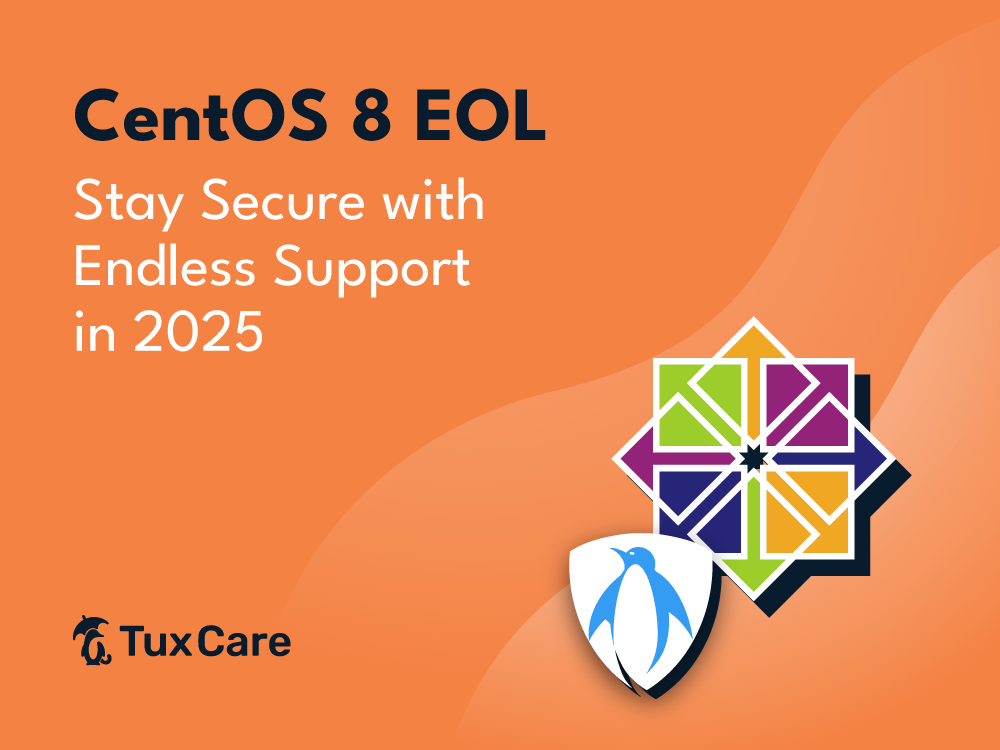Key Takeaways
- CentOS 8 no longer receives official security updates, leaving systems vulnerable to security threats and compliance risks.
- You have two options to secure your systems: migrate to a supported OS like AlmaLinux, Rocky Linux, or RHEL, or extend CentOS 8’s security with third-party support.
- TuxCare’s Endless Lifecycle Support for CentOS 8 provides ongoing security patches for as long as needed, preventing the need for immediate migration.
A large majority of web hosts and servers use CentOS as their default operating system – mostly because of the amount of stability it offers and the fact that there is no cost associated with it. However, with Centos 8 EOL, open-source communities of enterprise users and web hosts now face a great amount of risk.
This article explains what CentOS 8 EOL means, the risks involved, and the best ways to keep your systems secure and compliant.
What Does CentOS 8 End of Life Mean For You?
When an operating system reaches end of life (EOL), it no longer receives official updates, security patches, or bug fixes from the manufacturer. CentOS 8 reached its end of life on December 31, 2021. For CentOS 8 users, this means:
- Security Risks: Unpatched vulnerabilities make your system an easy target.
- Software Issues: Applications and dependencies may break over time.
- Compliance Failures: Businesses in regulated industries risk non-compliance.
In 2019, Red Hat announced that the lifecycle of CentOS 8 would be coming to an end in 2021, rather than 2029, as it had originally been planned. With an upstream development platform designed for CentOS, Red Hat implored open-source communities to shift their focus onto CentOS Stream.
They also mentioned that there wouldn’t be CentOS Linux 9, either. Noticeably, this announcement left the community devastated without much room for error before transitioning to an alternative to CentOS 8.
4 Alternatives to CentOS 8 After EOL
The community of web hosts and enterprise users at large has shown a negative view of CentOS Stream, as it isn’t equivalent to CentOS Linux, or CentOS 8. The community believes that the Centos 8 EOL announcement has been detrimental to its once stable and no-cost enterprise operating system and that CentOS Stream is purely motivated by profit and monetary incentives.
If you’re looking for a stable, long-term replacement, here are four solid alternatives to consider:
1. AlmaLinux
AlmaLinux is widely regarded as the best direct successor to CentOS Linux. This community-driven, open-source, and forever-free OS maintains application binary compatibility with RHEL, ensuring a seamless transition for CentOS users. It offers a stable, free alternative for those looking to migrate from CentOS while maintaining enterprise-grade reliability. Although sponsored by CloudLinux, AlmaLinux operates under a non-profit organization with no usage restriction and no license fee, making it the closest match to CentOS Linux.
2. Rocky Linux
Rocky Linux is another community-driven enterprise OS engineered for compatibility with the RHEL. Developed by Gregory Kurtzer, one of CentOS’s original co-founders, Rocky Linux is under consistent development in the community, offering stability with regular updates at no cost.
3. Oracle Linux
Oracle Linux is another free alternative to CentOS 8. This version was engineered with Red Hat Enterprise Linux roots. They benefit production systems and boast a vast community, as the OS is backed by Oracle.
Enterprise users that leverage Oracle Linux face a few drawbacks, which are their paid support service and some compatibility issues that pop up when migrating or integrating products that aren’t supported by Oracle.
4. RHEL (Red Hat Enterprise Linux)
RHEL is a commercial enterprise-grade Linux distribution offering long-term support, stability, and extensive security updates. While it’s a paid service, RHEL is a reliable alternative for businesses that require a fully supported and certified platform, with excellent resources, certification options, and professional support.
Should You Migrate from CentOS 8?
Whether to migrate from CentOS 8 once your CentOS version reaches EOL, will depend on your security needs, compliance requirements, and long-term plans. It’s a risk to stay on unsupported operating systems, but, like with most things, there are options for dealing with this:
Migrate to another OS
Switching to alternatives like RHEL, AlmaLinux or Rocky Linux, ensures long-term stability and support. But this can involve substantial costs, including budget, time, and resources. Additionally, transitioning an entire server fleet is a complex and resource-intensive process that includes planning, testing, and implementation. Critical systems’ migrations pose even higher risks.
Extend the CentOS 8 Lifecycle
Extended support solutions like Endless Lifecycle Support provide ongoing security patches and help manage the significant risk that comes with CentOS 8 EOL. This also buys you extra time and makes the transition to an alternative Linux distribution smooth while minimizing risk and vulnerabilities.
How to Migrate from CentOS 8
Migrating from CentOS 8 requires careful planning to prevent downtime and compatibility issues. Before you begin, back up your system — including files, databases, and configurations — and test the backups to ensure they restore correctly.
Follow these steps to perform a smooth and secure migration.
Step 1: Update Repository Paths
First, check your CentOS 8 version using the following command.
cat /etc/redhat-release
If your version is below 8.5, update repository paths:
sed -i -r 's|^(mirrorlist.+)$|#\1|g; s|^#baseurl=http://mirror.centos.org/\$contentdir/\$releasever/|baseurl=https://vault.centos.org/8.5.2111/|g' /etc/yum.repos.d/CentOS-*.repo
Next, update and reboot the system.
sudo yum update -y && sudo reboot
Step 2: Download and Run the AlmaLinux Migration Script
Run this command to download the migration script almalinuxdeply.sh
curl -O https://raw.githubusercontent.com/AlmaLinux/almalinux-deploy/master/almalinux-deploy.sh
Then, run the migration script.
sudo bash almalinux-deploy.sh
After completion, it should display the output text.
Migration to AlmaLinux is completed
If the script fails due to a signature verification error, import the AlmaLinux GPG key and run the script again:
sudo rpm --import https://repo.almalinux.org/almalinux/RPM-GPG-KEY-AlmaLinux sudo bash almalinux-deploy.sh
Step 3: Verify Migration and Reboot:
Check if the migration succeeded:
cat /etc/redhat-release
It should display:
AlmaLinux release 8.7 (Stone Smilodon)
Finally, reboot your system:
sudo reboot
Once your system restarts, you’re now running AlmaLinux 8 with full support and updates.
For a complete step-by-step guide on migrating from CentOS 8 to AlmaLinux 8 and then upgrading to AlmaLinux 9, follow our detailed CentOS Migration Guide.
A Solution for CentOS 8 EOL: Endless Lifecycle Support
The CentOS 8 EOL announcement put companies, servers, and enterprise hosts in a tough spot with no update about the release date for newer versions. However, TuxCare’s Endless Lifecycle Support (ELS) nearly turned the CentOS 8 EOL news into a non-event because organizations can continue to receive CentOS patches for years to come.
In fact, TuxCare is able to extend the life of CentOS 8 for as long as needed. With these additional years, organizations can have plenty of extra time to figure out which distribution they’ll use next.
TuxCare delivers ongoing security patches for CentOS 6, CentOS 7 EOL, CentOS 7.9 EOL, CentOS 8.4 and 8.5, and CentOS 9, covering over 130 packages, including the Linux kernel, glibc, OpenSSL, Apache, Python, and more.
How Extended Lifecycle Support Keeps Your CentOS 8 Systems Secure After EOL
If there is any vulnerability found, TuxCare deploys patches for it across the Linux systems that it supports, including multiple versions of CentOS.
Organizations can minimize the exploitation of vulnerabilities by relying on TuxCare’s in-house developers, who analyze if bug fixes are needed promptly and release patches if necessary – which are just as effective as the vendor’s.
Get in touch with TuxCare’s Linux security experts to extend the life of your CentOS 8 EOL systems and give yourself ample time to migrate to an alternative Linux distribution.
Watch: How TuxCare Creates Endless Lifecycle Support (ELS) Patches.
Summary

CentOS 8 EOL: Stay Secure with Endless Support in 2025
Description
CentOS 8 EOL is here. Learn how to maintain a secure system with endless support throughout 2025. Ensure your system stays safe and up-to-date.
Author
Ananya Tiwari
TuxCare
Publisher Logo

💸 Affordable Cloud Servers in Argentina! 🚀
At Full Tech Solutions, we offer Affordable Cloud Servers with high performance and advanced security, perfect for entrepreneurs, businesses, and developers looking for power at a budget-friendly price.
💰 Competitive Pricing: Power and flexibility without breaking the bank.
⚡ High Performance: Speed and stability for your applications.
🔒 Advanced Security: Protect your data with cutting-edge technology.
📞 24/7 Support: Our experts are ready to assist you anytime.
Don’t compromise quality for cost. Choose Full Tech Solutions and get the best affordable cloud servers in Argentina.
🌐 Scale your project with performance and savings!




